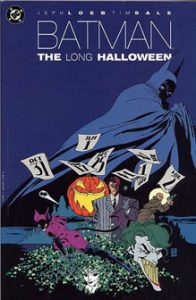This is part of a series where I look back at various works of “Batman” lore from the perspective of a casual “Batman” fan who enjoys the current TV series, “Gotham.”
In addition to its titular tie-in to the holiday, I found “The Long Halloween” (1996-97) to be a good “Batman” story to read now because it gives us comic-book portrayals of most of the rogues’ gallery to contrast with what we know from “Gotham.”
At 13 issues, it’s not a one-sitting read, but it’s much less decompressed than the four-issue “Dark Knight Returns.” Writer Jeph Loeb and artist Tim Sale use big panels and colorist Gregory Wright favors black-and-white (even though it’s a color comic) to create a noir-soaked collection that flows like “Year One,” at least when read today. When it came out, this story was released over a 13-month span, so it must’ve felt like a very slow-burn yarn.

“Batman: The Long Halloween” (1996-97)
DC, 13 issues
Writer: Jeph Loeb
Artists: Tim Sale (pencils, inks), Gregory Wright (colors)
The origin of Two-Face
The mystery – who is the Holiday killer? – is engaging and the character arcs are as dense as they should be, yet “The Long Halloween” is easy to follow. Additionally, “The Long Halloween” is the origin story of Two-Face on the timeline launched by “Year One.” (The Batman Wiki tells me that “Batman Annual” No. 14, from 1990, first told this story, from a different angle.)
Two-Face is the one major villain “Gotham” has avoided; I think this is in part because Harvey Dent so clearly becomes Two-Face AFTER Bruce Wayne has assumed the Batman mantle (there’s arguably some wiggle room with other villains), and in part because Christopher Nolan’s films so recently told Two-Face’s origin story (and even that came close on the heels of the Burton/Schumacher saga’s telling).
The comic presents a Gotham ruled by Carmine “The Roman” Falcone’s crime empire, something familiar to fans of the current season of “Gotham.” The comics’ Falcone is more in the ruthless Italian mobster mode than John Doman’s calm turn on the TV series, not because of a difference in behavior, but because we see behind the scenes of his empire rather than being limited to sly conversations with Jim Gordon. Most surprising to me is his daughter, Sophia Falcone Gigante, who is indeed a musclebound giant, quite a contrast to the lithe and gorgeous Crystal Reed on the TV show.
Maybe “Gotham” will mutate Sophia via the Indian Hills chemical spill as it recently did with henchman-for-hire Butch Gilzean, who transforms into Solomon Grundy in the current Season 4. I didn’t know about this mid-level rogue before “Gotham,” and in “The Long Halloween” I don’t know much more about him other than that he’s a large nutjob who lives in the sewers and repeats that he was “born on a Monday.” His personality and lifestyle reminds me a bit of the unpredictable Leatherhead from the Mirage “Teenage Mutant Ninja Turtles” comics.

Rogues take a holiday
The Penguin only makes a cameo at the end when Two-Face frees a bunch of rogues from Arkham Asylum. (He flips a coin to determine the release of each prisoner, and conveniently, it lands on heads for all our favorite baddies.) But most of the other A-list rogues serve the yarn in a way that ties in with the major holiday from each month.
For example, the green-favoring Poison Ivy seduces Bruce on St. Patrick’s Day, and the Riddler attempts to untangle the Holiday mystery on April Fool’s Day. Batman consults Julian Day, a.k.a. Calendar Man, a few times in Arkham; he might be the most significant rogue who hasn’t been referenced at all on “Gotham.”
Catwoman isn’t a villain here – she’s on her own side, as always – but she tries her darnedest to get Batman to run away from Gotham with her and start a new life. On the final panel of “Chapter 10: Independence,” Batman ruminates that avoiding a relationship with Catwoman is “the price of independence.”
As we delve into Bruce’s guilt about his mother’s death (he suggested she wear her pearls to the movies on that fateful night) in “Chapter 8: Mother’s Day,” and learn about Thomas Wayne’s relationship with the Falcone family in “Chapter 9: Father’s Day,” it’s clear that “The Long Halloween” is an excellent piece of “Batman” comic lore to read after “Year One.” Indeed, this feels like Year Two (although there is a different comic by that name).
The mystery is strong – I didn’t guess any of the killers by the end, but it all makes sense – as is the portrayal of how the good guys investigate the killings. I like how Batman, Captain Gordon and district attorney Harvey Dent make a rooftop pact to work together to bring down the Falcone crime enterprise.
Nolan borrows some elements
Indeed, Nolan acknowledges in an introduction in the 2011 trade paperback that he borrowed the concept of a good-guy triumvirate for his “Dark Knight” film trilogy, although he used Rachel Dawes in place of Dent in the first movie, and then chronicled Dent’s tragic fall in the second movie.
Despite its title, “The Long Halloween” isn’t a Halloween-focused yarn, so there are better “Batman” titles to read that are specific to the holiday or that aim for a horror mood, perhaps the “Legends of the Dark Knight” Halloween specials.
But this is the origin story of Two-Face on this timeline, Batman and Gordon are in fine brooding form early in their careers, and the spark between Batman and Catwoman is significant. The hold on Gotham by the Falcone and (to a lesser extent) Maroni crime families is palpable, but with most of the rogues – Poison Ivy for example — we just get a taste of their comic-book personalities that makes us want to delve further into the lore.
“The Long Halloween” is an essential “Batman” story that hasn’t aged a day since it hit comic-book shelves 20 years ago, except for the fact that we can now see how many subsequent projects it has influenced.

